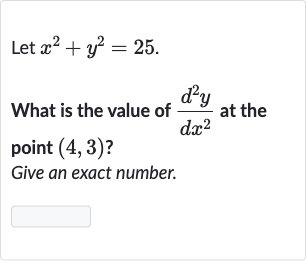Full solution
Q. Let .What is the value of at the point ?Give an exact number.
- Implicit Differentiation: We are given the equation of a circle . To find the value of at the point , we first need to implicitly differentiate the equation with respect to to find .Differentiating both sides of the equation with respect to , we get:
- Finding : Now we solve for :
- Substitute Point: We substitute the point into the equation for to find its value at that point: at
- Second Derivative: Next, we need to differentiate with respect to again to find . This is the second derivative we are looking for.Differentiating with respect to , we get:
- Quotient Rule: To differentiate , we will use the quotient rule: , where and . Let's find and : (which we found earlier to be )
- Simplify Expression: Now we apply the quotient rule:
- Substitute Point: We simplify the expression:
- Substitute Point: We simplify the expression:Now we substitute the point into the equation for to find its value at that point: at = at = at =
More problems from Linear approximation
QuestionGet tutor help

